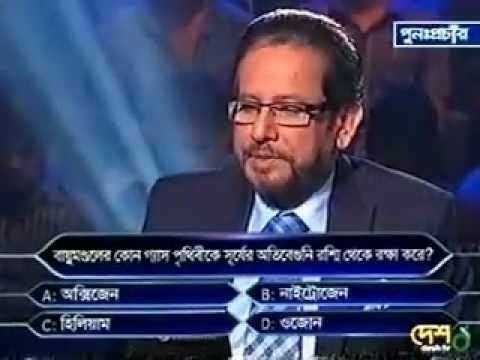Running time 60 minutes Final episode date 2 November 2011 | Country of origin Bangladesh No. of seasons 1 First episode date 10 July 2011 Number of seasons 1 Genre Game show | |
 | ||
Producer(s) Delta Bay Production & Distribution Pvt. Ltd. Similar Game show, Who Wants to Be a Millionair, Wie wordt euromiljonair?, Who Wants to Be a Millionair, Who Wants to Be Rich? | ||
Shehabon shakib in the game show ke hote chay kotipoti on desh tv
Ke Hotey Chay Kotipoti? (Bengali: কে হতে চায় কোটিপতি?, also mentioned as Ke Hote Chay Kotipoti or KHK) is a Bangladeshi game show based on the original British format of Who Wants to Be a Millionaire?. The program will be broadcast from 10 July 2011.
Contents
There would be 52 episodes in the first series. It is a Delta Bay Bangladesh production and Delta Bay is the official licensee for the show in Bangladesh. The first series is broadcast on the Bangladeshi TV station Desh TV. Cultural personality Asaduzzaman Noor is hosting the show.
Rules
As in the UK version, the contestants must undergo an initial round of "Fastest Finger First", in which the host introduces the ten contestants of the episode and asks them all the same question. The contestants must then arrange the answers in the order described in the question. The contestant that places the four options in the correct order in the fastest time gets the chance to go on the "hotseat".
All contestants must be over the age of 18 and a citizen of Bangladesh in order to be eligible. The person must not be a former "Ke Hotey Cahay Kotipoti" contestant and must be a resident of Bangladesh.
At the hot seat, the contestant is asked a series of general knowledge questions consistently rising in difficulty with every question. Each question has four options with only one correct answer. The contestant wins a certain amount of money with each correct answer, and may choose to give up and retain the money they have already won if they decide not to answer the currently shown question. There is no Time Limit.
The money won after each question is roughly doubled from the previous amount won, exponentially increasing the amount won after each correct answer until the contestant reaches the final question, after which they win the maximum prize (currently 1 crores in KHK 1).
History
Who Wants to Be a Millionaire? has been a great hit all over the world. People of Bangladesh have also been watching the Hindi version Kaun Banega Crorepati since 2000. They were also expecting a game show like this. That's why Desh TV arranged this show. Ke Hotay Chay Kotipoti is going to be Bangladesh's first official international show.
